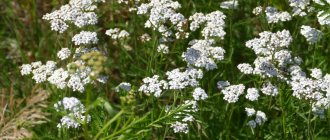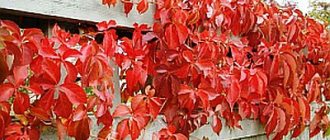Home » Flowers and plants » Outdoor plants » ? Perennials
Olga Polyakova 04/06/2020
33746 Views
Flowers – growing in spring
According to the calendar, spring begins on March 1st. But nature naturally does not pay attention to human formalities. For nature, the beginning of spring means the departure of cold weather, the melting of snow, and, of course, the appearance of the first flowers. Flowers that bloom in spring are usually the most vibrant and memorable of the entire plant world. This impression is further strengthened because during their flowering the trees are still not covered with leaves, and the ground has not been put in order after the cold weather. Let's look at different spring flowers depending on when they bloom.
About the features of cultivation
All primroses have a special development cycle. During the period when all nature is reborn after winter and begins to actively vegetate, they have already experienced the most active phase of their life. This occurs in April-May depending on the type of plant and variety.
Primroses are always planted in open ground in the fall from September to November in order to admire their flowering in early spring. Places chosen are open, drained, and sunny. Suitable areas are between stones, under trees that do not yet have leaves in the spring and the area is completely open to the sun.
Bulbs or plots of perennials are planted with the condition that in the summer their above-ground part will either be completely absent or lose its decorative effect. That is, you need to plant them in groups near summer ornamental plants and shrubs.
In the garden, an interesting option is to plant bulbs in the lawn. In a few years they will grow and will delight the eye with entire flowering meadows.
Primroses are not only beautiful plants, but also very easy to care for. They do not require watering or any agrotechnical measures. It is enough just to feed them 1-2 times a year and plant them if necessary.
Crocuses
Miniature bushes with large bright flowers in the spring flower bed - crocuses. They bloom immediately after snowdrops. They bloom profusely for several weeks. They look beautiful in the foreground of a flower bed or on an alpine hill, or can be grown in a pot. Unpretentious, do not require special care. I have four varieties - you can see more details here and here.
Ultra early bulbous
There is still snow, but from under its cover the first messengers of spring - snowdrops - are beginning to break through, and in their place, one after another, other flowering bushes will delight us with bright colors.
Snowdrops
Snowdrops are the first to awaken from hibernation. Their white bell flowers appear as early as March, as soon as the snow melts. The botanical name of the plant is galanthus. Propagated by daughter bulbs or seeds. Prefers growing conditions close to natural. Terry varieties of snowdrops look especially impressive in the garden.
Groups of galanthus are planted under bushes, trees, and in partial shade, so that in summer the bulbs in the ground do not dry out in the scorching sun.
Next comes the turn of other bulbous early-blooming flowers:
- crocuses:
- hyacinths;
- muscari;
- scillas;
- erantis.
Crocuses
This is one of the most numerous groups of spring flowers in terms of color. They come in yellow, blue, purple, pink, and also have a two-color color. There are natural forms and hybrid ones, bred in Holland and having large flowers. Most often, the unpretentious crocus Tommasini and Anchira are grown in garden plots. The plant grows quickly, as it forms numerous children after flowering.
Crocuses, like hyacinths and tulips, are great for early forcing in containers. To do this, in November they are planted in a light substrate with a high sand content. By March the crocuses will bloom. For a spectacular appearance, plant 5-10 bulbs in a container.
Hyacinths
The bushes have not only an aesthetic appearance, but also a bright aroma, especially for Dutch varieties. In total, over the 5-century history of cultivation, more than 300 varieties of this plant have been bred. It is planted both in groups and individually on alpine hills or in combination with crocuses and tulips.
Muscari
The most unpretentious and bright primroses appear in the garden. Depending on the variety, they bloom from April to May. They bloom for about 1.5 weeks, after which the above-ground part dries out. Muscari are planted in groups to create the effect of a flowering carpet. The predominant colors of the inflorescences are white, blue, and purple.
Scilla
A low-growing plant with small flowers fits in. The botanical name is scylla. The Siberian scilla has bright blue flowers and is widely represented in the gardens of the middle zone. Extremely unpretentious and ideal for a garden landscape designed in a natural style. All the plant needs is moist, light soil during the flowering period. When planting a blueberry in the garden, you need to be prepared to restrain its active growth.
Erantis
This plant is also included in the list of ultra-early bulbous plants. It blooms in April with bright yellow flowers with a diameter of only 2-2.5 cm, and does not lose its decorative effect even during snowfalls. The plant reaches a height of 10 cm. It must be planted in groups; in single plantings it does not look impressive.
The list of early flowers for the garden can be supplemented with such representatives as irises (reticulated), daffodils, and hazel grouse. The latter are the most numerous and are represented by both dwarf species, similar to snowdrops, and large ones, reaching a height of 80-90 cm.
Daffodils
Representatives of the family are no less numerous in terms of varietal diversity. On the market you can find ultra-early bulbs and late ones that bloom in May. The most graceful among daffodils are:
- Ice King (double creamy white flowers with a diameter of 12-13 cm);
- Pink Champagne (white-pink crown flowers);
- Spelbinder (lemon trumpet flowers that change color to white in the center).
Delicate irises
Iris reticulum is a dwarf representative of irises. The botanical name is iridodictium. It reaches a height of 10 cm, so I plant it in groups on alpine hills or among the lawn.
Most bulbs do not need to be dug up. They can grow in one place for at least 5 years. The exception is plants that grow quickly and require more space. This also applies to tulips, which go deeper into the earth every year, causing the flowers to become smaller or not appear at all.
Tulips
The brightest and most long-awaited symbol of spring is the tulip. The plant is found both wild in fields and meadows, and cultivated. There are hundreds of developed varieties and hybrids. They differ in the size and color of the bulb, the height of the plant, the diameter and color of the flower, the timing of planting and flowering.
Tulip flowers can be goblet-shaped, oval, or cup-shaped. Petals can be simple, terry, or fringed. There are varieties that form several buds on one plant.
The earliest varieties of tulips that bloom at the end of March:
- Duke Van Tol (height 20 cm, flowers red-orange, yellow or pink, simple goblet-shaped);
- Monte Carlo (yellow, terry, 20 cm high);
- Abba (dwarf, scarlet, only 10 cm in height).
There are many more varieties of tulips that bloom from mid-April to the end of May. They are distinguished by a high stem up to 40-50 cm, a variety of shapes and colors of inflorescences. For abundant flowering they need moisture and nutritious soil. The more organic components it contains, the larger and brighter the flower will be, and the bulb will produce more children.
Tulips are grown in open ground and in containers. Bulbs are planted in the ground in October-November, depending on the region and weather. The soil temperature should not be higher than +10°C. The bulb must have time to take root before the onset of persistent frosts, but not develop the green above-ground part.
If the plant is used for container planting, the bulbs are planted in November and left in the cellar or other cool, dark room until January.
Plantings are watered 1-2 times per month to prevent the soil from completely drying out. In spring, tulips are fed 2 times with nitrogen and mineral fertilizers until flowering.
When the plant fades and the stem turns yellow, the bulbs are dug up, dried and stored in a ventilated area until autumn planting. Tulips differ from other early-blooming bulbs in that they are ideal for cutting and making bouquets.
Snowdrops
Spring primroses - snowdrops (galanthus). They bloom in my flowerbed in early April, immediately after the snow melts. Very easy to grow in the Moscow region. They reproduce by bulbs; they can grow in one place for up to 5 years, then they need to be replanted. Undemanding to care, frost-resistant.
Herbaceous early flowering perennials
Perennials are very convenient to grow, as they do not take much time and are usually less demanding than annuals. For several years in a row they occupy a permanent place in the garden, grow and delight with their decorative properties. Knowing the exact timing of flowering of plants, it is possible to form so-called gardens of continuous flowering, highly decorative throughout the warm season of the year.
Spring primrose
Primrose is the most numerous early perennial in terms of varietal characteristics. The first green leaves of the plant appear in March, and blooms from April to May. Primrose bushes are compact, from 8 to 20 cm in height. The inflorescences are simple or double white, yellow, burgundy. Propagated by dividing the bush and seeds. Can be grown in open ground and containers.
Among the variety of varieties, there are representatives with flowers similar to muscari, they are called muscariodes. There are so-called candelabra primroses, the peduncles of which are very tall, and the inflorescences are arranged in a circle in a ring.
The varieties are highly decorative:
- high primrose (Alba, Colossea, Rosea);
- primula serrata (with ball-shaped inflorescences of blue or purple color);
- large-cupped primrose (with yellow flowers of heterogeneous color, has medicinal properties).
Primulas are divided into early-blooming, mid-blooming and late-blooming, and some species bloom twice per season - in early spring and late summer.
Hellebore Caucasian
Hellebore - differs from other early-flowering plants in that it is planted in the garden in early spring, as soon as the soil thaws a little. Its greenery remains decorative all season due to its dense and tough green leaves. The plant is frost-resistant, strong and highly decorative. It blooms starting from February in warm regions, and from April in cold regions. Hybrid varieties are used in the garden, which are distinguished by the variety of flower colors and their diameter. Hellebores can be white, purple, yellow and pink.
Anemone long-haired
Anemone is a delicate and unpretentious flower, popularly called Anemone. It blooms in April with white, pink, pale purple flowers on tall stems. There are both simple and hybrid forms with double flowers. It grows quickly due to its creeping rhizome; most often its growth must be restrained. After the plant fades, the greenery of the bush remains decorative until the beginning of winter. In the long and warm autumn, the anemone blooms again.
Terry marsh marigold
Marigold is a resident of humid and swampy regions. In the garden it is used to decorate ponds. It is a compact bush with bright yellow flowers. Hybrids have double flowers.
Early and mid-blooming primroses include daisies, forget-me-nots, periwinkle, leotard and dicentra, whose flowers look like a broken heart. All of them are unpretentious and perfectly adapted to the climatic conditions of the middle zone.
Daffodils
Bright double flowers on thin stems surrounded by thin green leaves - daffodils. It’s rare that a flowerbed is complete without these unpretentious perennials. There are many varieties of daffodils. I really like the bright yellow trumpet 'Carlton' and the large crowned white and yellow 'Las Vegas' - see photos. They look very impressive in a flowerbed among primroses. They bloom towards the end of April.
Rare exotics
In temperate climates, adapted varieties of tropical plants do well. One of them is Ornithogalum - a bulbous relative of hyacinth. The second name of the plant is Poultry Plant.
Ornithogalum umbellata
The following types of this primrose winter well and are easy to care for:
- umbrella (narrow thin leaves, white flowers, forms a lush green bush, blooms in April-May);
- drooping (height 40 cm, narrow leaves, tall peduncles, spike inflorescence strewn with small white bells);
- balance (winter-hardy dwarf species 15 cm high with large white flowers, blooms in May).
Sanguinaria terry
Sanguinaria canadensis is a miniature flower that blooms as soon as the snow melts. Flowering is long - about 3-4 weeks. The flowers look like tiny water lilies. This is a member of the poppy family, native to North America.
The plant is shade-tolerant, frost-resistant, unpretentious. It is not affected by diseases and pests and reproduces in plots. In the garden it is planted under trees and shrubs and quickly grows to entire clearings.
Kandyk Siberian
Kandyk is a rare bulbous plant from the lily family, similar in appearance to cyclamen. It blooms in April, and both flowers and leaves with brown spots are decorative. Forms dense bushes 30-40 cm high. The peduncles are tall, on which drooping flowers with bent petals of white, pink, purple and other shades are located. A winter-hardy and unpretentious plant, native to the northern regions.
Early flowers for the garden have one main advantage - they are highly anticipated when they bloom. They are the ones who symbolize the arrival of the long-awaited spring, even if there is still snow in the yard and the frost gets stronger at night.
Scilla
Small flowers surrounded by thin dark green leaves - scylla, scilla or blue snowdrop. Another small-bulbous perennial that begins to bloom in April. It happens with purple or blue flowers, like mine, less often with purple, white or pink flowers. The height of the bush usually does not exceed 10-15 cm. It grows well in one place for up to 5 years. In the photo there is a scilla "Sibirskaya".
What flowers can be seen in Crimea
In Crimea, spring comes much earlier, so many tourists visit the peninsula to admire the bright colors. In April and May you can see the following plants:
- periwinkle;
- hellebore;
- muscari;
- pansies;
- daffodils;
- clean;
- daisies;
- tulips;
- primrose;
- magnolia;
- snowdrops;
- crocuses;
- goose onion;
- scroll.
In addition to popular types of crops in Crimea, you can find flowering shrubs and trees in April.
Hellebore
This perennial plant is called "Christ's Rose". Hellebore received this name not only because its delicate flowers are as spectacular as those of the queen of the garden. According to legend, this plant was first found near the stable where Jesus was born. In the south, hellebore blooms in winter, reminiscent of the birth of Christ, and in Europe - in spring, and often the flowers bloom at Easter.
The generally accepted name of the plant speaks for itself. Hellebore often blooms under the snow at sub-zero temperatures.
Today, decorative varieties and hybrids of hellebore with white, pink, red, yellow, deep purple and almost black flowers are especially popular.
Primrose
Tiny bushes with bright flowers are perennial primroses. This unpretentious flower blooms at the end of April. There are many varieties of primroses in shape and color, but they have one thing in common - they captivate at first sight. This perennial is easy to grow even for a novice gardener, since primroses do not require special care and grow quickly. Primrose can be planted in the foreground of flower beds, in borders, on an alpine hill, in garden flowerpots - they will be appropriate anywhere.
Pushkinia
A spectacular primrose, very similar to hyacinth - Pushkinia. This perennial bulbous plant blooms towards the end of April. Miniature bushes no more than 15 cm high look impressive in any flower bed. Pushkinia can also be grown on alpine hills, in pots and garden flowerpots. Suitable for forcing. Not demanding, grows well in any conditions. The photo shows Pushkinia variety “Lebanese”.
In outskirts of Moscow
The Moscow region differs from other regions in its variable climate. Therefore, in early spring you can find the following types of flowers:
- snowdrop;
- crocus;
- muscari;
- iris reticulum;
- vernal;
- scilla;
- hellebore;
- primrose;
- grouse;
- periwinkle.
Also at the end of May you can see blooming peonies of various varieties and lilac bushes.
Why do some plants bloom in the spring before their leaves bloom?
- For some plant species, it is important that the flowers are not covered by foliage. Thus, the inflorescences are easily found by insects, and if it is a wind-pollinated plant, then there are no obstacles to the pollination process.
Pollen grains under a microscope
Pollen from wind-pollinated plants has some features:
- each inflorescence contains a large amount of pollen
- the surface of pollen grains is smooth, there is no sculpture characteristic of plant seed material
- pollen grains are light, their structure is dusty
- pollen has no smell
- inflorescences are most often underdeveloped
- inflorescences may lack petals (there is no need to attract pollinators, pollination is successful without petals)
- stamens and pistils have significant differences in size
The production of highly volatile pollen grains in large quantities is an evolutionary adaptation of flora representatives to pollination by wind. These plants do not need foliage in the spring, as it interferes with the pollination process.
Wind-pollinated plants: alder
Foliage is not a hindrance to insect-pollinated representatives of the flora: spider beetles themselves find inflorescences, the pollen grains of which are characterized by the following features:
- Pollen grains of insect-pollinated plants are heavier
- The surface of pollen grains has a sticky structure
- Pollen grains have a characteristic sculpture
- Due to the curved shapes, pollen grains cling more easily to the flower of another plant
- Wind-pollinated plants need a large amount of pollen in order for at least some of the pollen grains scattered in the wind to reach their goal - to land on the pistil of the inflorescence of another tree.
Flower structure
Tulips
And although the tulip is considered a flower of May, there are early varieties that bloom at the end of April. I’ll show you the most unusual one in my collection - a tiny tulip “Tarda Dasystemon” (15-20 cm high). Bright yellow petals with a white border look very impressive. One plant produces up to 4 buds at the same time, so just a few bushes create the illusion of multiple plantings. Tulips of this variety are disease-resistant, do not require annual digging, are unpretentious and winter well in the Moscow region.
Lungwort
This spring plant is interesting because it simultaneously displays pink and blue-violet flowers. According to legend, blue flowers symbolize Adam, and pink flowers symbolize Eve. And the plant itself is the embodiment of the unity of opposites.
But science explains this phenomenon differently. It's all about the pigments responsible for the color of the petals. When the acidity of the cell sap decreases, the flowers become blue (this occurs during the aging process of the plant organism), and when the acidity increases, they become pink.
After flowering ends until the first snow appears, the flowerbed continues to be decorated with attractive lungwort leaves. Currently, varieties with spotted foliage have gained particular popularity.
The leaves of the plant have long been used in the treatment of pulmonary diseases.
What flowers bloom in spring for bouquets
Most often, tulips, peonies, daffodils and snowdrops are used to form bouquets. Also in spring there are bouquets formed from various shades of hyacinth. However, if you wish, you can create a bouquet from almost any type of spring flowers that have individual attractive characteristics.
And you can also check out another selection, also with photographs, of perennials blooming with white flowers.











